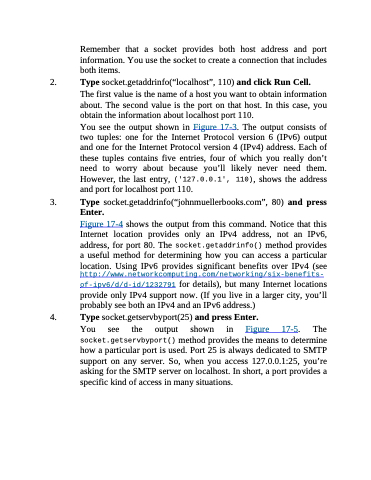Page 393 - Beginning Programming with Pyth - John Paul Mueller
P. 393
Remember that a socket provides both host address and port information. You use the socket to create a connection that includes both items.
2. Type socket.getaddrinfo(“localhost”, 110) and click Run Cell.
The first value is the name of a host you want to obtain information about. The second value is the port on that host. In this case, you obtain the information about localhost port 110.
You see the output shown in Figure 17-3. The output consists of two tuples: one for the Internet Protocol version 6 (IPv6) output and one for the Internet Protocol version 4 (IPv4) address. Each of these tuples contains five entries, four of which you really don’t need to worry about because you’ll likely never need them. However, the last entry, ('127.0.0.1', 110), shows the address and port for localhost port 110.
3. Type socket.getaddrinfo(“johnmuellerbooks.com”, 80) and press Enter.
Figure 17-4 shows the output from this command. Notice that this
Internet location provides only an IPv4 address, not an IPv6,
address, for port 80. The socket.getaddrinfo() method provides
a useful method for determining how you can access a particular
location. Using IPv6 provides significant benefits over IPv4 (see
http://www.networkcomputing.com/networking/six-benefits- of-ipv6/d/d-id/1232791 for details), but many Internet locations provide only IPv4 support now. (If you live in a larger city, you’ll probably see both an IPv4 and an IPv6 address.)
4. Type socket.getservbyport(25) and press Enter.
You see the output shown in Figure 17-5. The socket.getservbyport() method provides the means to determine how a particular port is used. Port 25 is always dedicated to SMTP support on any server. So, when you access 127.0.0.1:25, you’re asking for the SMTP server on localhost. In short, a port provides a specific kind of access in many situations.


